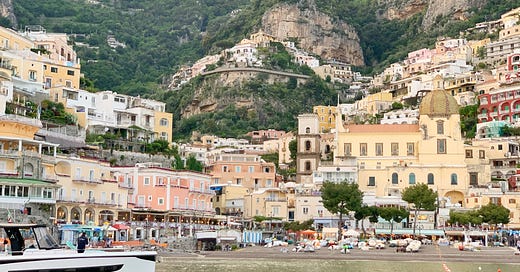Welcome to the New Roman Times’ 72 Hours series! Why 72 hours? Because the New York Times publishes a “36 Hours” series, but in my opinion, 36 hours isn’t nearly enough time to spend in Italy’s greatest cities and most compelling regions. From time to time, I’ll spotlight popular destinations like Milan, Florence, Venice, and the Amalfi Coast for paid subscribers. Have a place you’d like a 72 hours guide to? Email newromantimes@substack.com or leave a comment here!
I distinctly remember visiting the Amalfi Coast for the first time circa 2010, while living in Rome between college and graduate school. My sister had come to visit me and we decided to spend a couple of days on the mythical coast that everyone seemed to be talking about.
We took the Frecciarossa high-speed train to Naples, then got on the slower Circumvesuviana train to Sorrento, and finally boarded a bus bound for Positano—probably the most arduous way to get there. The bus was so packed we couldn’t find seats and we struggled to hold ourselves together during the drive on the winding coastal road. But when we finally arrived in Positano, I literally laughed out loud upon catching sight of the town’s absurd beauty. How can a place like this, with buildings stacked on top of each other, seemingly spilling down the cliffs toward the sea, possibly exist? It seemed to defy all logic.
I’ve returned to the Amalfi Coast at least half a dozen times since then, seizing every chance I can get to spend some time in this magical place. That said, there are still many parts of the coast I have yet to explore. I always go in the shoulder season (roughly between Easter and the end of May or in September or October, after the busy summer season has ended), so I haven’t spent much time at the beaches or dined at the famous beach-front restaurants like Da Adolfo or Lo Scoglio. However, I’ve been lucky enough to stay at many of the region’s best hotels, explore some of the most charming towns, and enjoy some fantastic meals. Here’s my guide to 72 hours on the Amalfi Coast featuring some of my personal highlights.
DAY ONE: Positano
In three days, you can see the three most famous towns on the coast: Positano, Amalfi, and Ravello. John Steinbeck, one of the people responsible for making the Amalfi Coast famous in the 1950s, wrote, “Positano bites deep. It is a dream place that isn’t quite real when you are there and becomes beckoning real after you have gone.” He was definitely right about that.
12 p.m. - Arrive in Positano and check in at Le Sirenuse
No need to take multiple trains and buses like I did on my first trip. There are ferries that will bring you directly from Naples to Positano. Or you could arrange a car transfer, but I would only suggest doing that if you’re traveling in the shoulder season because in the summer, the traffic is infernal.
There are a few wonderful hotels in Positano, but there’s no doubt that the most iconic one is Le Sirenuse, where Steinbeck stayed when he wrote that article for the May 1953 issue of Harper’s Bazaar. A member of the Leading Hotels of the World, Le Sirenuse was the holiday home of the illustrious Sersale family from Naples, who opened it up to guests in 1951. Today it’s run by the charming Antonio Sersale, his wife Carla, and their two sons Aldo and Francesco, who are constantly undertaking projects to improve it.
1 p.m. - Lunch at a Positano institution
After settling into your room, head down to the beach for lunch at the beachfront restaurant Chez Black, an institution in Positano since 1949. The nautical decor, lively atmosphere, and great people watching make it a fun spot.
3 p.m. - Il dolce far niente
Take a post-lunch break to relax on the beach, stroll through the town, or go for a boat ride along the coast. There are lots of chic boutiques selling linen clothes, accessories, and other souvenirs. I’m a fan of Antica Sartoria by Giacomo Cinque for boho-chic dresses, caftans, and beach cover-ups that exude Amalfi Coast style.
If you prefer to go for a boat ride, check to see if Le Sirenuse’s fishing boat is available. The hotel also has a weekly calendar of activities like morning hikes, wine tastings, and a flower tour of the property. Or just relax by the pool and learn the art of il dolce far niente.
Keep reading with a 7-day free trial
Subscribe to The New Roman Times to keep reading this post and get 7 days of free access to the full post archives.






